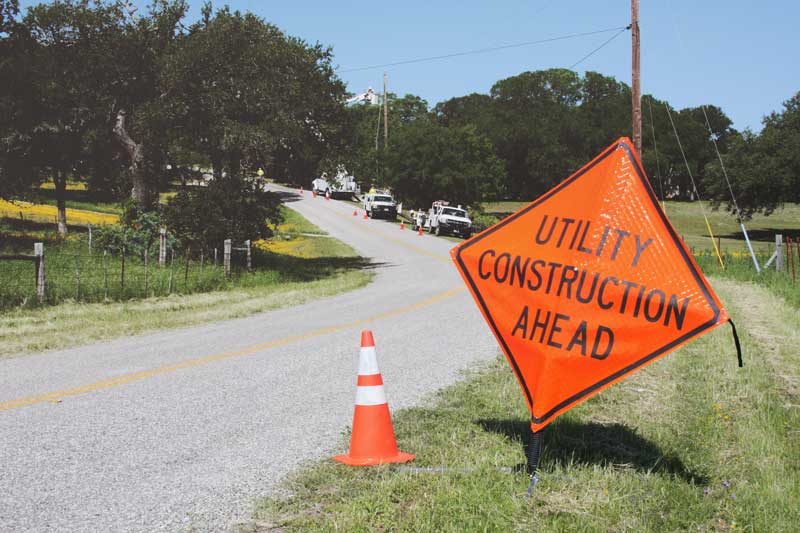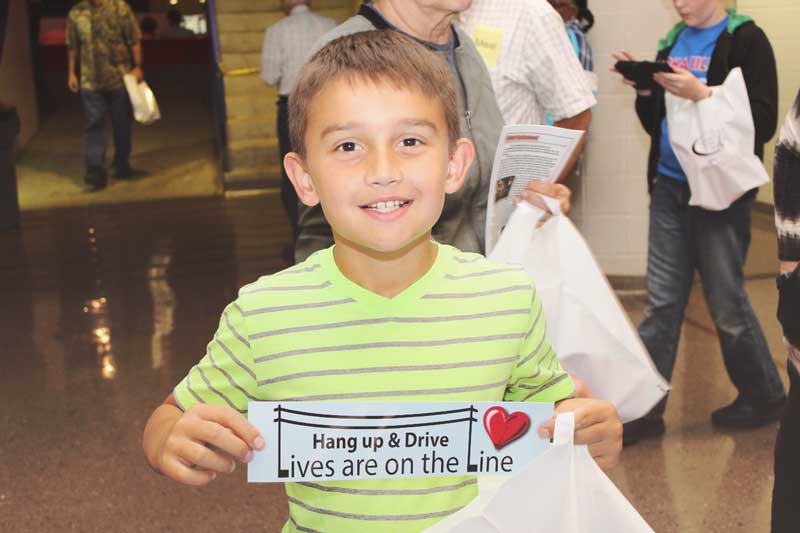
(Photo by Katie Haby/Medina Electric Co-op)
It was a routine two-hour job. The crew discussed it at the shop and went over the details again at the site before setting up the work zone. The morning was typical mid-summer Minnesota: overcast but dry. Traffic on that stretch of county road might total six to eight vehicles passing in either direction every hour.
"We were building a three-phase line for new construction," says crew chief Dan Houselog, a journeyman line technician and 30-year veteran with Tyler-based Lyon-Lincoln Electric Cooperative. "We were going to swing it across two spans, so we had six guys in the crew.
"We set up 'Utility Work Ahead' signs north and south and 'Be Prepared to Stop' signs a halfmile up the highway on either side, and we had orange cones across the road."
With three basket trucks up, lights flashing, and two flaggers working the road, two phases were pulled into position and the third was going up. Things were going well, until they weren't.
"A gravel truck was coming, and it wasn't slowing down," Houselog recalls. "I hollered out a warning."
Journeyman line technician Ross Birath had just enough time to let go.
"It happened fast. I saw the truck coming, and we all knew he was going to hit the wire," Birath says. "It was time to duck and cover."
The men aloft tucked in, dropping the line which was snagged by the truck and pulled tight until it snapped, whipsawing into a flagger, who dropped his stop sign and fell onto the asphalt roadway as the truck continued up the road.
"We saw the brake lights come on. He slowed down, but he kept going," says Birath, who estimates the vehicle was traveling about 40 mph. "He might have heard something hit the truck, but it wasn't enough for him to stop."
The shaken men descended to check on their fallen coworker, Houselog recalls. "By the time I got to the ground and ran over to him, he was standing up. Luckily, the line just caught his leg."
There were seven co-op vehicles in the intersection when the incident occurred: three bucket trucks, a digger-derrick, a utility trailer, and a pickup. The work zone was about a mile long, with ample signage and flashing lights.
And still it wasn't enough.
Hazardous Conditions
Many co-ops work with their statewide associations to ensure operations staff get several hours of work zone training every 12 to 18 months, Parr says. He also recommends co-ops build relationships with state and local transportation and public safety agencies because they may provide perimeter assistance during emergency restoration projects.
"We have an obligation to look after the safety of our employees and the motoring public," says Leonard Farris of G&T North Carolina Electric Membership Corp. (NCEMC). "The greatest challenges we face are from distracted drivers and speeders."
As NCEMC's director of training and safety, Farris oversees ongoing instruction and recertification programs for operations personnel who are required by state law to complete several hours of training focused on working in or adjacent to roads.
"Early in their apprentice training, trainees are not certified to do many of the tasks required of line crews, so they are trained and certified as flaggers," Farris says. "We also train other employees like warehousemen, groundsmen, and staking technicians to work as flaggers during emergencies."
'Multitasking Behind the Wheel'
According to the National Highway Safety Administration, there were 765 fatalities related to work zone traffic incidents in 2016, including 26 in North Carolina.
While most of these have been related to road construction projects, utility workers face similar risks when they work on power lines above or near roads or highways.
"This is why we design our work zones to slow motorists down and then provide visual information on the paths we want them to take through the area," Farris says. "We take into account the area needed to complete the job, the regular speeds on the adjacent roads, and any bends, turns, intersections, or lane deviations that exist within or near where we'll be working."
Federal work zone design standards dictate that utilities use familiar signage, cones, and other indicators encouraging motorists to slow down and be alert for potential hazards.
"Workers need to constantly be aware of both risks associated with the tasks they're trying to complete and the presence of vehicles and drivers trying to reach their destinations who may be multitasking behind the wheel," Federated's Parr says.
Messaging for Motorists

A young member holds up a bumper sticker with the slogan of the Louisiana statewide's anti-distracted-driving campaign. (Photo by Billy Gibson)
Safe Electricity, a public awareness program developed by the Energy Education Council, is running a national campaign designed to reduce work zone risks specifically for utility workers.
"There is a growing concern among utility leaders who've seen more deaths and injuries in recent years as a result of distracted driving," says Molly Hall, the council's executive director.
Work zone laws in many states include utility workers and their equipment and require motorists to change lanes if possible, slow down, and proceed with caution, Hall says. In some instances, workzone designations also prohibit cell phone use, for good reason: The risk of an accident is 23 times higher when a cell phone is used.
"When you see those orange signs and cones, you need to at least slow down. And if your lane is blocked, you need to stop," Hall says. "If someone bumps into a work truck, the bucket at the top is going to sway, and that could be enough to injure or kill a lineworker by putting them in contact with energized lines."
In Louisiana, lineworkers and other operations personnel prompted the statewide association to develop a major public education campaign. "Hang Up and Drive" has been supported with public service ads, social media, lobby display art, bumper stickers, and member outreach communications.
"A kid asked a lineman what scared or worried him most about his job, and it wasn't power lines," says Billy Gibson, director of communications Association of Louisiana Electric Cooperatives. "He said it was seeing people driving through work zones looking down at their phones."
While no formal polling was conducted, lineworkers and other operations personnel from several of the seven distribution co-ops that belong to the statewide association expressed similar concerns, Gibson says.
"They know their jobs and what they have to do to protect themselves from energized power lines, falls, and other risks, but distracted motorists pose really serious and unknown threats," Gibson says. "Life can be over in a minute, or people can suffer career-ending injuries."
Because a new crop of younger licensed drivers takes to the roads each year, the Louisiana statewide featured "Hang Up and Drive" messaging on the backs of its Electric Cooperative Youth Tour T-shirts, and has distributed thousands of key fobs featuring the slogan at schools and community events across the state.
"People are more distracted than ever behind the wheel," Gibson says. "It's not just music, and phones, and food, and conversations. It's makeup, pets, kids, and texting too, and in work zones, that can be fatal."
Plain Speaking
"Our guys are out on the road working in traffic every day," says Bruce Stumpe, a training instructor with the Association of Missouri Electric Cooperatives (AMEC). "We need to make sure that they have training on working in any vehicle situation they may encounter.
"In 2016, we had 2,560 crashes in work zones in Missouri. Preliminary 2017 data indicates there were 2,067 work zone crashes, and 13 of those resulted in fatalities," Stumpe says. "Motorists are not paying attention if they are on their phones, and when you add construction or worksites into the equation, the risk of traffic crashes dramatically increases."
Instead of soft-peddling the risks, Stumpe and other AMEC safety trainers speak plainly about the hazards and how even small incidents can have devastating results.
"The reality is death on Missouri roadways. We don't let them forget that," Stumpe says. "You always think it's going to be someone else, but it could be you. Statistics show that 90 percent of these crashes could be prevented, and the crashes are just as likely to occur in work zones as they are anywhere."
AMEC has invested in a distracted driving training program that includes use of a simulator to help give co-op crews a better idea of motorists' behavior. The goal of that program, Stumpe says, is for lineworkers and other operations personnel to see oncoming traffic as equally hazardous as the 7,200 volts of electricity flowing through the energized lines they're working on.
"We want them to know why maintaining a safe work zone is so important to getting through their days safely," says Tim Pirtle, a training instructor and compliance administrator with AMEC. "We try to explain that the flagger can be one of the most important guys on a job, because he's there keeping watch and doing all he can to control vehicles as they approach our crews."
After completing one cycle of simulator trainings through the state's distribution co-ops, Pirtle says he's continued to get requests for additional sessions. He says since the training began, none of the co-ops has reported any work zone injuries related to motor vehicle collisions.
"The guys in the buckets are trying to get their jobs done up there," Pirtle says. "It takes a team effort, and that includes someone on the ground to help them watch the traffic. We all want everyone to head home safely at the end of their shifts."
Written by Derrill Holly. This article is a reprint from RE Magazine. Used with permission.
 Lake Region Electric Cooperative
Lake Region Electric Cooperative